Case Study: Child Protection, Risk, and Intervention Strategies
VerifiedAdded on 2023/01/18
|12
|4370
|62
Case Study
AI Summary
This case study analysis examines the case of John, a six-year-old facing multiple challenges due to his parents' substance misuse, including learning difficulties, stuttering, and bullying. The assignment applies Holder and Morton's elements of safety to analyze risk and protective factors, focusing on threats, harm, vulnerability, and imminent danger. It evaluates the short- and long-term impacts of these risks on the child, considering physical, mental, and social well-being. The analysis further explores the implications for the child and family, supported by relevant literature, and discusses child protection systems, legislation, and prevention/intervention approaches across all three tiers of intervention to support the child and family. The study highlights the importance of addressing child neglect and abuse, the impact on mental health, and the need for comprehensive support systems.
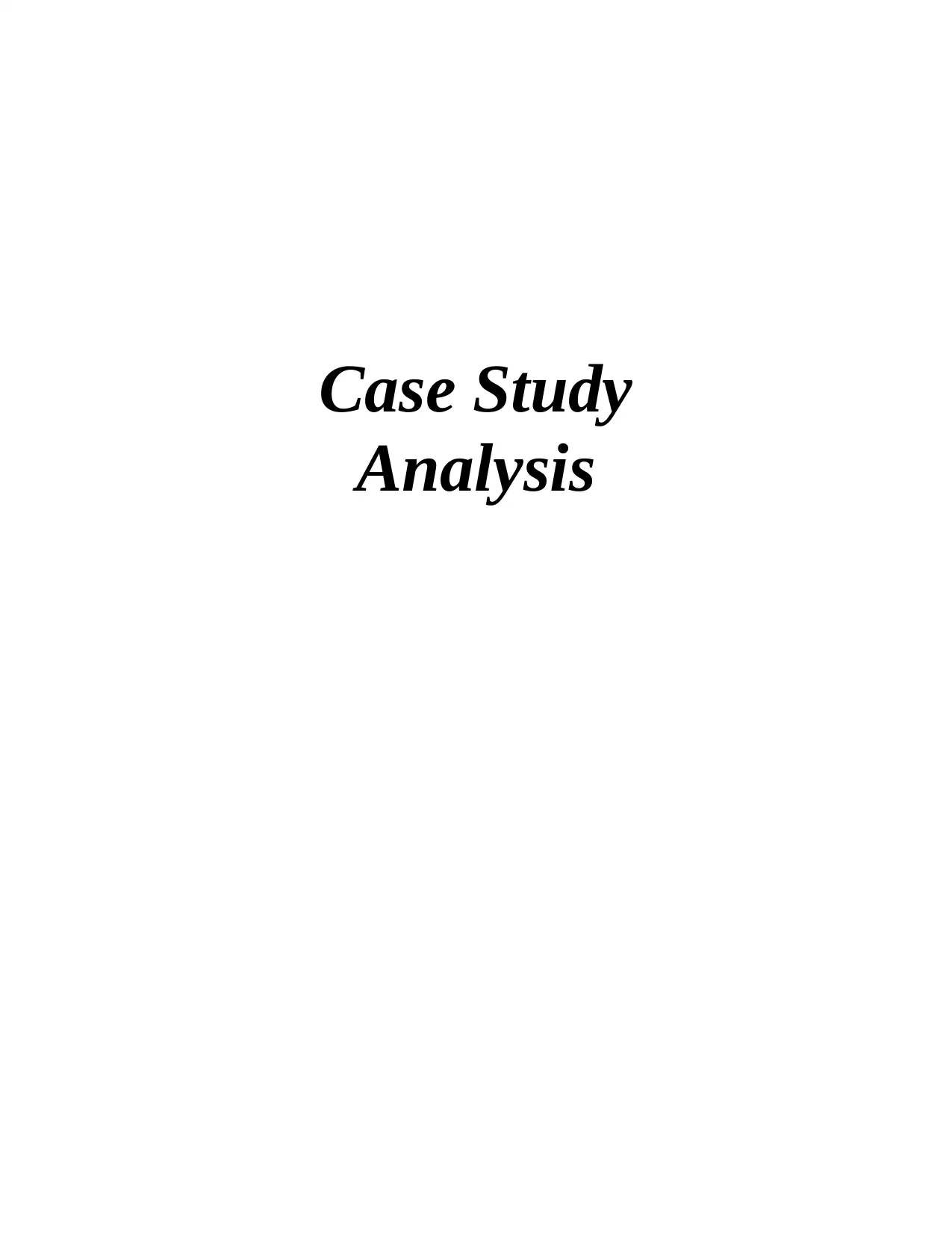
Case Study
Analysis
Analysis
Paraphrase This Document
Need a fresh take? Get an instant paraphrase of this document with our AI Paraphraser
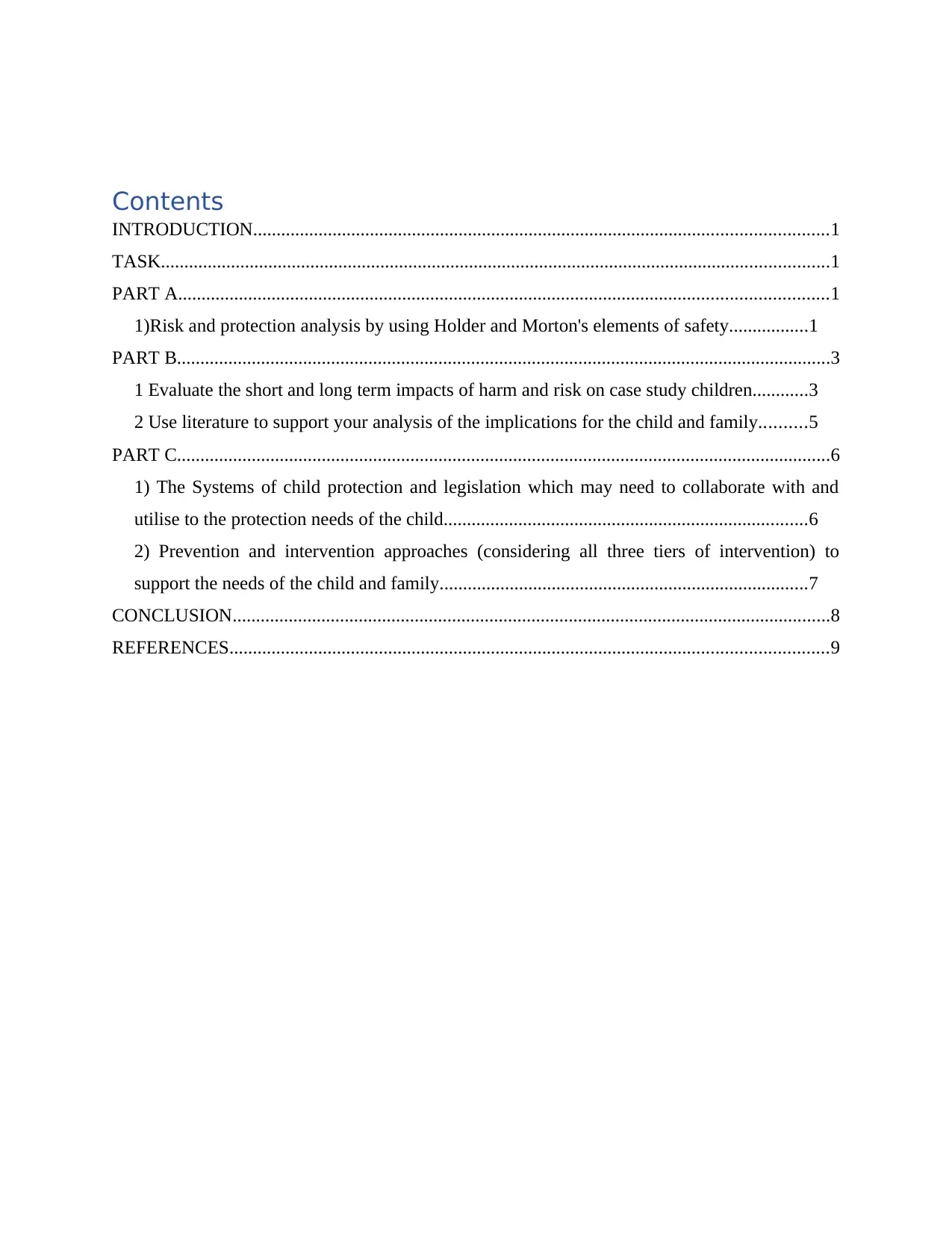
Contents
INTRODUCTION...........................................................................................................................1
TASK...............................................................................................................................................1
PART A...........................................................................................................................................1
1)Risk and protection analysis by using Holder and Morton's elements of safety.................1
PART B............................................................................................................................................3
1 Evaluate the short and long term impacts of harm and risk on case study children............3
2 Use literature to support your analysis of the implications for the child and family..........5
PART C............................................................................................................................................6
1) The Systems of child protection and legislation which may need to collaborate with and
utilise to the protection needs of the child..............................................................................6
2) Prevention and intervention approaches (considering all three tiers of intervention) to
support the needs of the child and family...............................................................................7
CONCLUSION................................................................................................................................8
REFERENCES................................................................................................................................9
INTRODUCTION...........................................................................................................................1
TASK...............................................................................................................................................1
PART A...........................................................................................................................................1
1)Risk and protection analysis by using Holder and Morton's elements of safety.................1
PART B............................................................................................................................................3
1 Evaluate the short and long term impacts of harm and risk on case study children............3
2 Use literature to support your analysis of the implications for the child and family..........5
PART C............................................................................................................................................6
1) The Systems of child protection and legislation which may need to collaborate with and
utilise to the protection needs of the child..............................................................................6
2) Prevention and intervention approaches (considering all three tiers of intervention) to
support the needs of the child and family...............................................................................7
CONCLUSION................................................................................................................................8
REFERENCES................................................................................................................................9
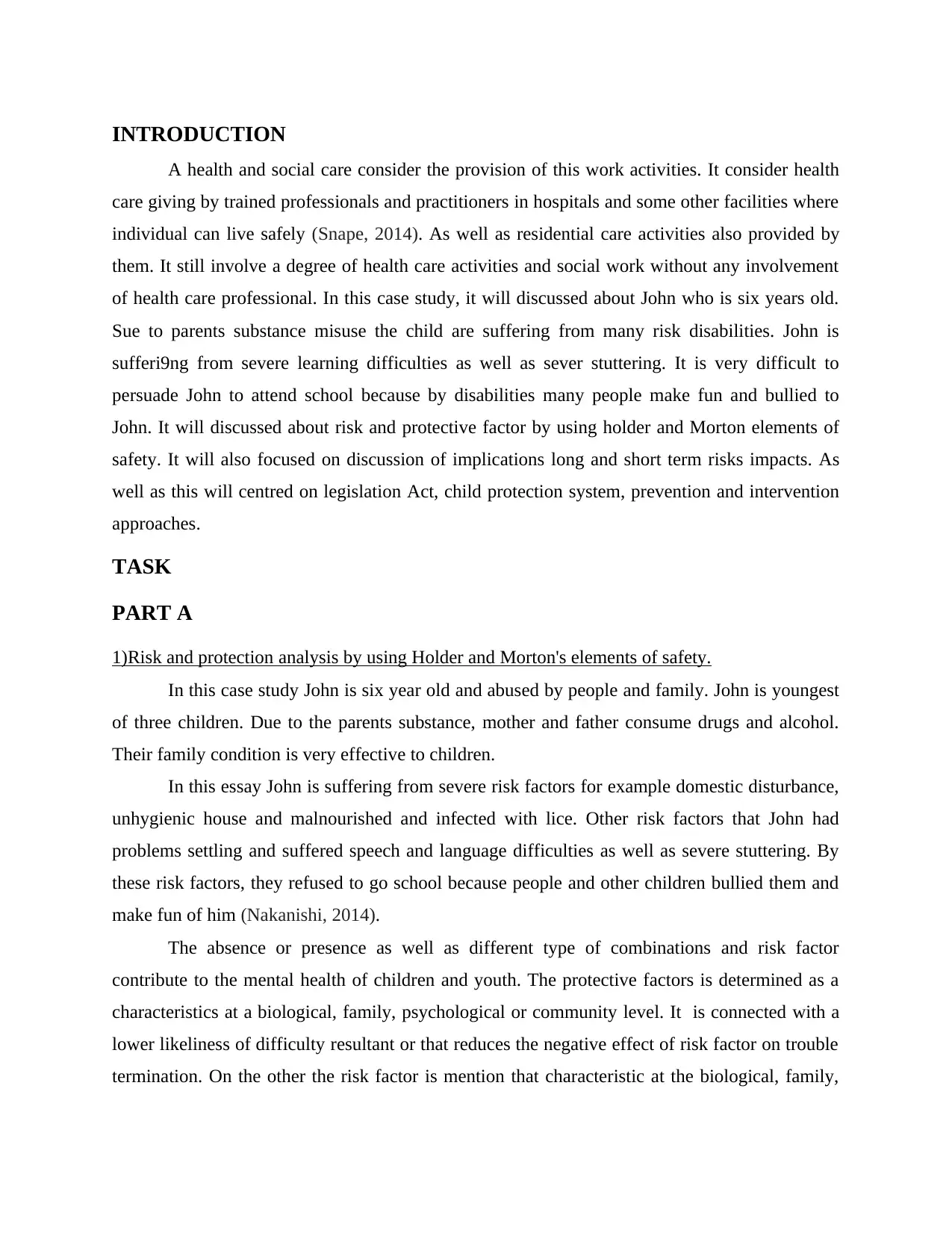
INTRODUCTION
A health and social care consider the provision of this work activities. It consider health
care giving by trained professionals and practitioners in hospitals and some other facilities where
individual can live safely (Snape, 2014). As well as residential care activities also provided by
them. It still involve a degree of health care activities and social work without any involvement
of health care professional. In this case study, it will discussed about John who is six years old.
Sue to parents substance misuse the child are suffering from many risk disabilities. John is
sufferi9ng from severe learning difficulties as well as sever stuttering. It is very difficult to
persuade John to attend school because by disabilities many people make fun and bullied to
John. It will discussed about risk and protective factor by using holder and Morton elements of
safety. It will also focused on discussion of implications long and short term risks impacts. As
well as this will centred on legislation Act, child protection system, prevention and intervention
approaches.
TASK
PART A
1)Risk and protection analysis by using Holder and Morton's elements of safety.
In this case study John is six year old and abused by people and family. John is youngest
of three children. Due to the parents substance, mother and father consume drugs and alcohol.
Their family condition is very effective to children.
In this essay John is suffering from severe risk factors for example domestic disturbance,
unhygienic house and malnourished and infected with lice. Other risk factors that John had
problems settling and suffered speech and language difficulties as well as severe stuttering. By
these risk factors, they refused to go school because people and other children bullied them and
make fun of him (Nakanishi, 2014).
The absence or presence as well as different type of combinations and risk factor
contribute to the mental health of children and youth. The protective factors is determined as a
characteristics at a biological, family, psychological or community level. It is connected with a
lower likeliness of difficulty resultant or that reduces the negative effect of risk factor on trouble
termination. On the other the risk factor is mention that characteristic at the biological, family,
A health and social care consider the provision of this work activities. It consider health
care giving by trained professionals and practitioners in hospitals and some other facilities where
individual can live safely (Snape, 2014). As well as residential care activities also provided by
them. It still involve a degree of health care activities and social work without any involvement
of health care professional. In this case study, it will discussed about John who is six years old.
Sue to parents substance misuse the child are suffering from many risk disabilities. John is
sufferi9ng from severe learning difficulties as well as sever stuttering. It is very difficult to
persuade John to attend school because by disabilities many people make fun and bullied to
John. It will discussed about risk and protective factor by using holder and Morton elements of
safety. It will also focused on discussion of implications long and short term risks impacts. As
well as this will centred on legislation Act, child protection system, prevention and intervention
approaches.
TASK
PART A
1)Risk and protection analysis by using Holder and Morton's elements of safety.
In this case study John is six year old and abused by people and family. John is youngest
of three children. Due to the parents substance, mother and father consume drugs and alcohol.
Their family condition is very effective to children.
In this essay John is suffering from severe risk factors for example domestic disturbance,
unhygienic house and malnourished and infected with lice. Other risk factors that John had
problems settling and suffered speech and language difficulties as well as severe stuttering. By
these risk factors, they refused to go school because people and other children bullied them and
make fun of him (Nakanishi, 2014).
The absence or presence as well as different type of combinations and risk factor
contribute to the mental health of children and youth. The protective factors is determined as a
characteristics at a biological, family, psychological or community level. It is connected with a
lower likeliness of difficulty resultant or that reduces the negative effect of risk factor on trouble
termination. On the other the risk factor is mention that characteristic at the biological, family,
⊘ This is a preview!⊘
Do you want full access?
Subscribe today to unlock all pages.

Trusted by 1+ million students worldwide
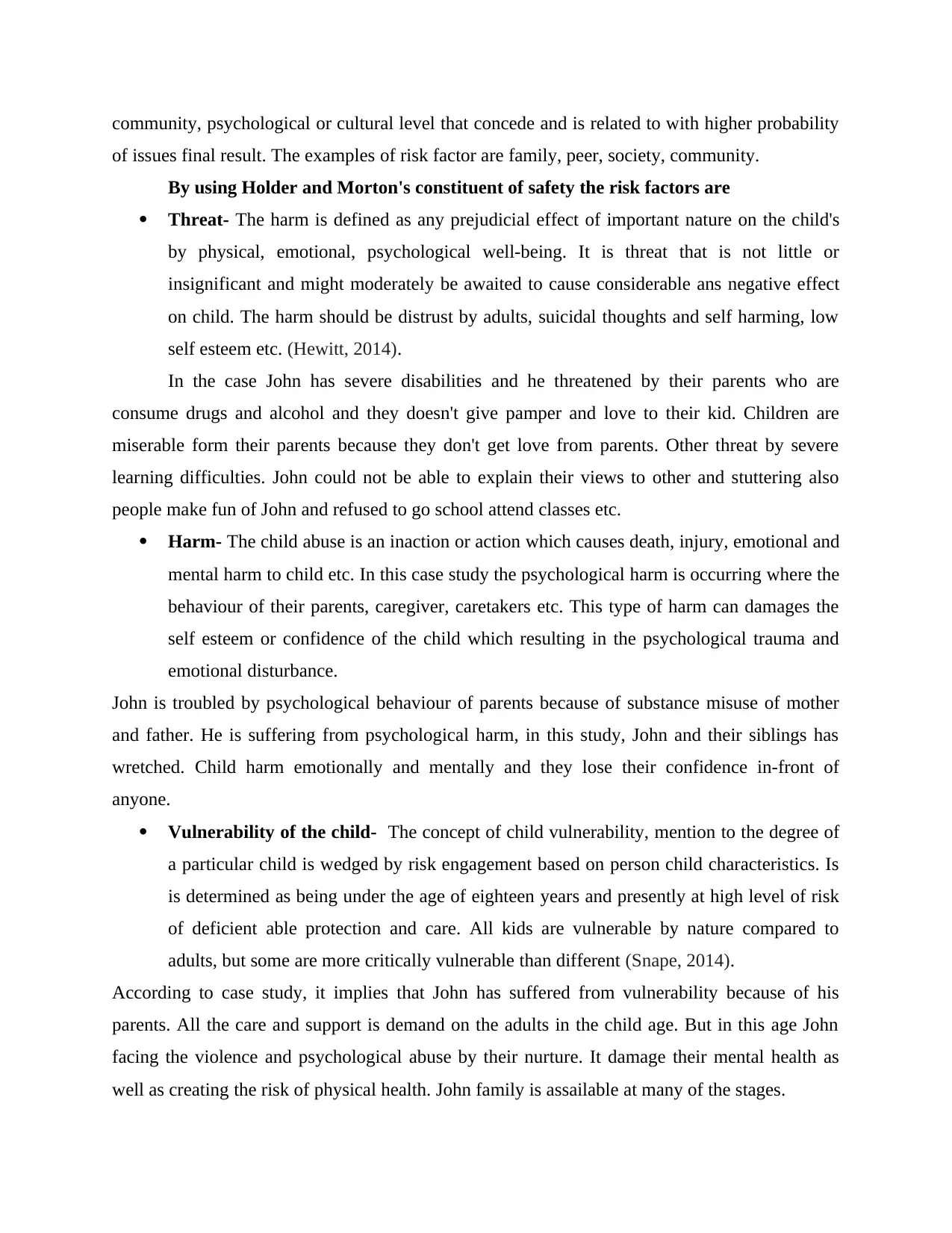
community, psychological or cultural level that concede and is related to with higher probability
of issues final result. The examples of risk factor are family, peer, society, community.
By using Holder and Morton's constituent of safety the risk factors are
Threat- The harm is defined as any prejudicial effect of important nature on the child's
by physical, emotional, psychological well-being. It is threat that is not little or
insignificant and might moderately be awaited to cause considerable ans negative effect
on child. The harm should be distrust by adults, suicidal thoughts and self harming, low
self esteem etc. (Hewitt, 2014).
In the case John has severe disabilities and he threatened by their parents who are
consume drugs and alcohol and they doesn't give pamper and love to their kid. Children are
miserable form their parents because they don't get love from parents. Other threat by severe
learning difficulties. John could not be able to explain their views to other and stuttering also
people make fun of John and refused to go school attend classes etc.
Harm- The child abuse is an inaction or action which causes death, injury, emotional and
mental harm to child etc. In this case study the psychological harm is occurring where the
behaviour of their parents, caregiver, caretakers etc. This type of harm can damages the
self esteem or confidence of the child which resulting in the psychological trauma and
emotional disturbance.
John is troubled by psychological behaviour of parents because of substance misuse of mother
and father. He is suffering from psychological harm, in this study, John and their siblings has
wretched. Child harm emotionally and mentally and they lose their confidence in-front of
anyone.
Vulnerability of the child- The concept of child vulnerability, mention to the degree of
a particular child is wedged by risk engagement based on person child characteristics. Is
is determined as being under the age of eighteen years and presently at high level of risk
of deficient able protection and care. All kids are vulnerable by nature compared to
adults, but some are more critically vulnerable than different (Snape, 2014).
According to case study, it implies that John has suffered from vulnerability because of his
parents. All the care and support is demand on the adults in the child age. But in this age John
facing the violence and psychological abuse by their nurture. It damage their mental health as
well as creating the risk of physical health. John family is assailable at many of the stages.
of issues final result. The examples of risk factor are family, peer, society, community.
By using Holder and Morton's constituent of safety the risk factors are
Threat- The harm is defined as any prejudicial effect of important nature on the child's
by physical, emotional, psychological well-being. It is threat that is not little or
insignificant and might moderately be awaited to cause considerable ans negative effect
on child. The harm should be distrust by adults, suicidal thoughts and self harming, low
self esteem etc. (Hewitt, 2014).
In the case John has severe disabilities and he threatened by their parents who are
consume drugs and alcohol and they doesn't give pamper and love to their kid. Children are
miserable form their parents because they don't get love from parents. Other threat by severe
learning difficulties. John could not be able to explain their views to other and stuttering also
people make fun of John and refused to go school attend classes etc.
Harm- The child abuse is an inaction or action which causes death, injury, emotional and
mental harm to child etc. In this case study the psychological harm is occurring where the
behaviour of their parents, caregiver, caretakers etc. This type of harm can damages the
self esteem or confidence of the child which resulting in the psychological trauma and
emotional disturbance.
John is troubled by psychological behaviour of parents because of substance misuse of mother
and father. He is suffering from psychological harm, in this study, John and their siblings has
wretched. Child harm emotionally and mentally and they lose their confidence in-front of
anyone.
Vulnerability of the child- The concept of child vulnerability, mention to the degree of
a particular child is wedged by risk engagement based on person child characteristics. Is
is determined as being under the age of eighteen years and presently at high level of risk
of deficient able protection and care. All kids are vulnerable by nature compared to
adults, but some are more critically vulnerable than different (Snape, 2014).
According to case study, it implies that John has suffered from vulnerability because of his
parents. All the care and support is demand on the adults in the child age. But in this age John
facing the violence and psychological abuse by their nurture. It damage their mental health as
well as creating the risk of physical health. John family is assailable at many of the stages.
Paraphrase This Document
Need a fresh take? Get an instant paraphrase of this document with our AI Paraphraser
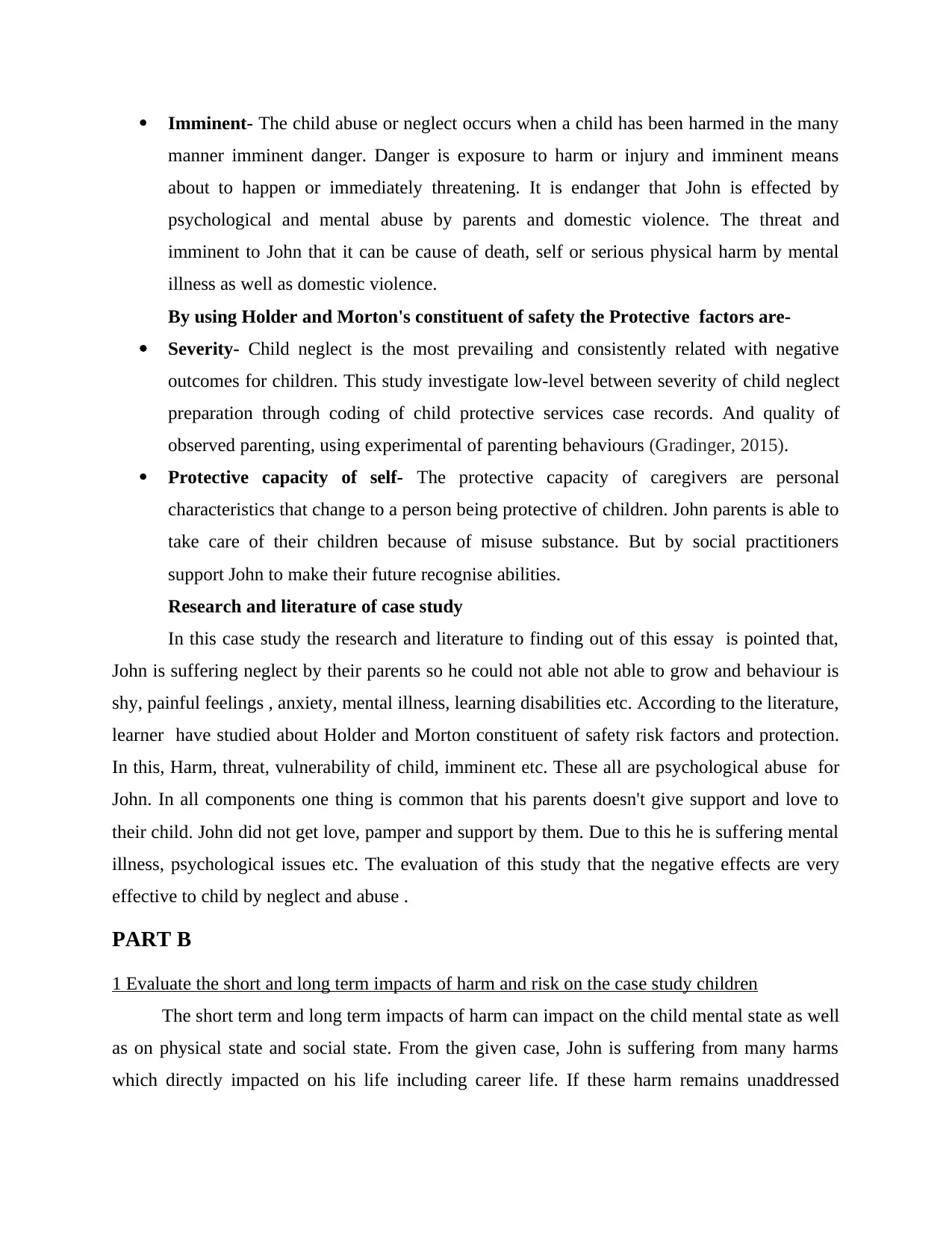
Imminent- The child abuse or neglect occurs when a child has been harmed in the many
manner imminent danger. Danger is exposure to harm or injury and imminent means
about to happen or immediately threatening. It is endanger that John is effected by
psychological and mental abuse by parents and domestic violence. The threat and
imminent to John that it can be cause of death, self or serious physical harm by mental
illness as well as domestic violence.
By using Holder and Morton's constituent of safety the Protective factors are-
Severity- Child neglect is the most prevailing and consistently related with negative
outcomes for children. This study investigate low-level between severity of child neglect
preparation through coding of child protective services case records. And quality of
observed parenting, using experimental of parenting behaviours (Gradinger, 2015).
Protective capacity of self- The protective capacity of caregivers are personal
characteristics that change to a person being protective of children. John parents is able to
take care of their children because of misuse substance. But by social practitioners
support John to make their future recognise abilities.
Research and literature of case study
In this case study the research and literature to finding out of this essay is pointed that,
John is suffering neglect by their parents so he could not able not able to grow and behaviour is
shy, painful feelings , anxiety, mental illness, learning disabilities etc. According to the literature,
learner have studied about Holder and Morton constituent of safety risk factors and protection.
In this, Harm, threat, vulnerability of child, imminent etc. These all are psychological abuse for
John. In all components one thing is common that his parents doesn't give support and love to
their child. John did not get love, pamper and support by them. Due to this he is suffering mental
illness, psychological issues etc. The evaluation of this study that the negative effects are very
effective to child by neglect and abuse .
PART B
1 Evaluate the short and long term impacts of harm and risk on the case study children
The short term and long term impacts of harm can impact on the child mental state as well
as on physical state and social state. From the given case, John is suffering from many harms
which directly impacted on his life including career life. If these harm remains unaddressed
manner imminent danger. Danger is exposure to harm or injury and imminent means
about to happen or immediately threatening. It is endanger that John is effected by
psychological and mental abuse by parents and domestic violence. The threat and
imminent to John that it can be cause of death, self or serious physical harm by mental
illness as well as domestic violence.
By using Holder and Morton's constituent of safety the Protective factors are-
Severity- Child neglect is the most prevailing and consistently related with negative
outcomes for children. This study investigate low-level between severity of child neglect
preparation through coding of child protective services case records. And quality of
observed parenting, using experimental of parenting behaviours (Gradinger, 2015).
Protective capacity of self- The protective capacity of caregivers are personal
characteristics that change to a person being protective of children. John parents is able to
take care of their children because of misuse substance. But by social practitioners
support John to make their future recognise abilities.
Research and literature of case study
In this case study the research and literature to finding out of this essay is pointed that,
John is suffering neglect by their parents so he could not able not able to grow and behaviour is
shy, painful feelings , anxiety, mental illness, learning disabilities etc. According to the literature,
learner have studied about Holder and Morton constituent of safety risk factors and protection.
In this, Harm, threat, vulnerability of child, imminent etc. These all are psychological abuse for
John. In all components one thing is common that his parents doesn't give support and love to
their child. John did not get love, pamper and support by them. Due to this he is suffering mental
illness, psychological issues etc. The evaluation of this study that the negative effects are very
effective to child by neglect and abuse .
PART B
1 Evaluate the short and long term impacts of harm and risk on the case study children
The short term and long term impacts of harm can impact on the child mental state as well
as on physical state and social state. From the given case, John is suffering from many harms
which directly impacted on his life including career life. If these harm remains unaddressed

through out life then this can affect on child on a short term as well as on a long term basis. The
short term and long term basically describe as the tendency of an situation that how long it
impact on life. If the situation can easily recovered then it is a short term impact but if it is
affecting and not recovering then it can be a long term threat. These are basically depends on the
situation that how a person adapt this situation in which manner. So it is necessary to evaluate
these Long term and short term harms which are described below.
The short term impacts includes the stammering as it means child have difficulties in
language speaking. It can directly impact on child social and education life. In context of John,
the many children teases him due to his disability. This will decrease the morale of child and
problems can occur in building the relationship between social and education communities. This
is a short term impact as the child can improve his habits of stuttering. With this problem the
child face many difficulties in building the friendship with others and faces bulling.
The Long term impact includes the unhygienic conditions in the house which can cause
allergies on a long term basis. The children of the house are suffering from ma-lnourishment
which can cause many disease in the body. It is also can be a reason of improper growth of any
part of the body from which lots of complications can occur. This also includes the mental retard
which will affect the social life of children. The child also suffers from lice as they are infected
from them. This can cause the various disease in the body. Due to parents substance misuse, the
children are affecting mentally as they experiencing a bad environment of their house. From this
the changes in their behavior can be seen. With this problem they are developing the un-
attachment with their parents and as well as with the communities.
The changes in behavior of child would effect on his career. As he faces problem in
achieving the placement in the school which can be a long term impact in his life. The John and
sisters have difficulties in learning which can also be a long term impact on each of the
individuals life. He faces many difficulties in making friends and people were bulling with his
situations, this would make the child mentally disturbed. The children's parents use substance
misuse which make the environment of house violent and inappropriate. The environment oh
house is deteriorated which makes the children to part ways in foster house which can be a long
term impact on children mental state. As the changes start appearing in their thoughts and also in
behavior.
short term and long term basically describe as the tendency of an situation that how long it
impact on life. If the situation can easily recovered then it is a short term impact but if it is
affecting and not recovering then it can be a long term threat. These are basically depends on the
situation that how a person adapt this situation in which manner. So it is necessary to evaluate
these Long term and short term harms which are described below.
The short term impacts includes the stammering as it means child have difficulties in
language speaking. It can directly impact on child social and education life. In context of John,
the many children teases him due to his disability. This will decrease the morale of child and
problems can occur in building the relationship between social and education communities. This
is a short term impact as the child can improve his habits of stuttering. With this problem the
child face many difficulties in building the friendship with others and faces bulling.
The Long term impact includes the unhygienic conditions in the house which can cause
allergies on a long term basis. The children of the house are suffering from ma-lnourishment
which can cause many disease in the body. It is also can be a reason of improper growth of any
part of the body from which lots of complications can occur. This also includes the mental retard
which will affect the social life of children. The child also suffers from lice as they are infected
from them. This can cause the various disease in the body. Due to parents substance misuse, the
children are affecting mentally as they experiencing a bad environment of their house. From this
the changes in their behavior can be seen. With this problem they are developing the un-
attachment with their parents and as well as with the communities.
The changes in behavior of child would effect on his career. As he faces problem in
achieving the placement in the school which can be a long term impact in his life. The John and
sisters have difficulties in learning which can also be a long term impact on each of the
individuals life. He faces many difficulties in making friends and people were bulling with his
situations, this would make the child mentally disturbed. The children's parents use substance
misuse which make the environment of house violent and inappropriate. The environment oh
house is deteriorated which makes the children to part ways in foster house which can be a long
term impact on children mental state. As the changes start appearing in their thoughts and also in
behavior.
⊘ This is a preview!⊘
Do you want full access?
Subscribe today to unlock all pages.

Trusted by 1+ million students worldwide
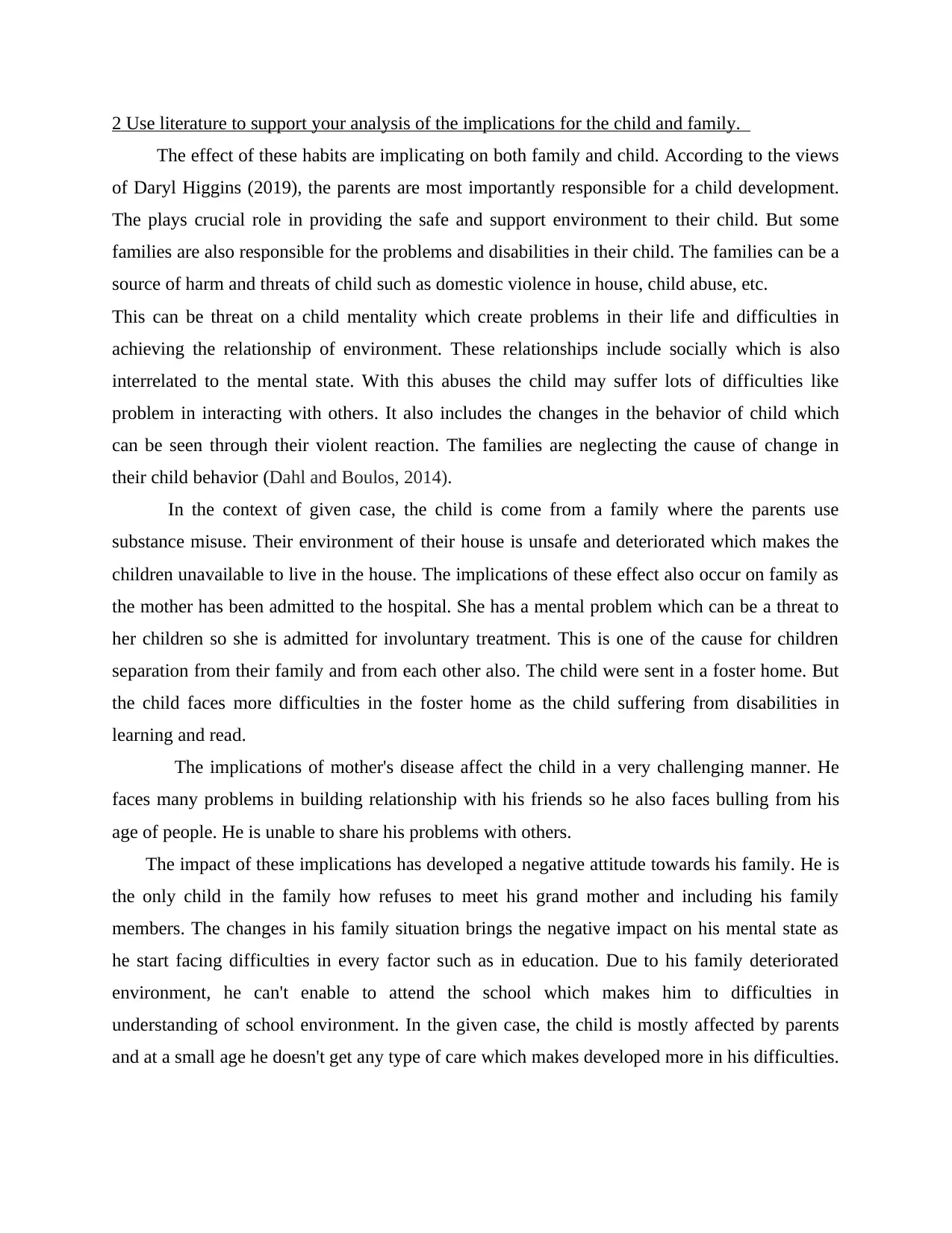
2 Use literature to support your analysis of the implications for the child and family.
The effect of these habits are implicating on both family and child. According to the views
of Daryl Higgins (2019), the parents are most importantly responsible for a child development.
The plays crucial role in providing the safe and support environment to their child. But some
families are also responsible for the problems and disabilities in their child. The families can be a
source of harm and threats of child such as domestic violence in house, child abuse, etc.
This can be threat on a child mentality which create problems in their life and difficulties in
achieving the relationship of environment. These relationships include socially which is also
interrelated to the mental state. With this abuses the child may suffer lots of difficulties like
problem in interacting with others. It also includes the changes in the behavior of child which
can be seen through their violent reaction. The families are neglecting the cause of change in
their child behavior (Dahl and Boulos, 2014).
In the context of given case, the child is come from a family where the parents use
substance misuse. Their environment of their house is unsafe and deteriorated which makes the
children unavailable to live in the house. The implications of these effect also occur on family as
the mother has been admitted to the hospital. She has a mental problem which can be a threat to
her children so she is admitted for involuntary treatment. This is one of the cause for children
separation from their family and from each other also. The child were sent in a foster home. But
the child faces more difficulties in the foster home as the child suffering from disabilities in
learning and read.
The implications of mother's disease affect the child in a very challenging manner. He
faces many problems in building relationship with his friends so he also faces bulling from his
age of people. He is unable to share his problems with others.
The impact of these implications has developed a negative attitude towards his family. He is
the only child in the family how refuses to meet his grand mother and including his family
members. The changes in his family situation brings the negative impact on his mental state as
he start facing difficulties in every factor such as in education. Due to his family deteriorated
environment, he can't enable to attend the school which makes him to difficulties in
understanding of school environment. In the given case, the child is mostly affected by parents
and at a small age he doesn't get any type of care which makes developed more in his difficulties.
The effect of these habits are implicating on both family and child. According to the views
of Daryl Higgins (2019), the parents are most importantly responsible for a child development.
The plays crucial role in providing the safe and support environment to their child. But some
families are also responsible for the problems and disabilities in their child. The families can be a
source of harm and threats of child such as domestic violence in house, child abuse, etc.
This can be threat on a child mentality which create problems in their life and difficulties in
achieving the relationship of environment. These relationships include socially which is also
interrelated to the mental state. With this abuses the child may suffer lots of difficulties like
problem in interacting with others. It also includes the changes in the behavior of child which
can be seen through their violent reaction. The families are neglecting the cause of change in
their child behavior (Dahl and Boulos, 2014).
In the context of given case, the child is come from a family where the parents use
substance misuse. Their environment of their house is unsafe and deteriorated which makes the
children unavailable to live in the house. The implications of these effect also occur on family as
the mother has been admitted to the hospital. She has a mental problem which can be a threat to
her children so she is admitted for involuntary treatment. This is one of the cause for children
separation from their family and from each other also. The child were sent in a foster home. But
the child faces more difficulties in the foster home as the child suffering from disabilities in
learning and read.
The implications of mother's disease affect the child in a very challenging manner. He
faces many problems in building relationship with his friends so he also faces bulling from his
age of people. He is unable to share his problems with others.
The impact of these implications has developed a negative attitude towards his family. He is
the only child in the family how refuses to meet his grand mother and including his family
members. The changes in his family situation brings the negative impact on his mental state as
he start facing difficulties in every factor such as in education. Due to his family deteriorated
environment, he can't enable to attend the school which makes him to difficulties in
understanding of school environment. In the given case, the child is mostly affected by parents
and at a small age he doesn't get any type of care which makes developed more in his difficulties.
Paraphrase This Document
Need a fresh take? Get an instant paraphrase of this document with our AI Paraphraser

PART C
1) The Systems of child protection and legislation which may need to collaborate with and utilise
to the protection needs of the child.
There are many child protection law which work for child welfare. Their aim is to protect
the children from impairment and maltreatment. They ensure that the children must grow in safe
and effective environment. The legislation take actions to promote the child welfare. There are
many legislation which works for protecting child and from above all this there is a legislation in
the country. The child protection works for protecting child in Australia. It is an public law in
which the authorities are interfere in family to inception whether the child is safe or not.
With this framework, they conduct the intervention to promote children health in
mentally, emotionally, physically and socially. Their principles include the developing interest of
children in different activities, implementing early interventions so that children can be rescued
from any type of harm and risks. This jurisdiction consult with the children so that they can
analyse the issues which are affecting the children lives. There are many laws which works on
different agenda such as education needs, sexual abuse, family violence. There is a children
protection act which works for the protection of child, their safety, prevention from violence, etc.
There are many organization which arrange a home care environment outside the house.
They make arrangements on the basis of risk of maltreatment with children from their family.
According to child in given case, his family environment is inappropriate and deteriorated as his
parents use substance misuse. With the policy of child protection, the police inception the house
and they found the home unhygienic. There analyse found that children also suffering from
malnutrition and they are infected from lice. The authorities take actions for child welfare and
transfer the child in a foster home care. This will help the child to recover from the bad influence
from his previous home. But the child is having problem in learning and language difficulties. So
with the help of the law, they can provide the best manner education care so that he can
overcome from his problems. The child can feel by providing the guidance officer in the school
so that he can share his problems with the officers.
This legislation includes the child care services which can help the child in achieving the
placements for his future. The child requires special needs as he has difficulties in various factors
so the law can be used to protect the child from this. The authorize can provide the appropriate
environment & educational needs to the child and the child can be prevent from his situation.
1) The Systems of child protection and legislation which may need to collaborate with and utilise
to the protection needs of the child.
There are many child protection law which work for child welfare. Their aim is to protect
the children from impairment and maltreatment. They ensure that the children must grow in safe
and effective environment. The legislation take actions to promote the child welfare. There are
many legislation which works for protecting child and from above all this there is a legislation in
the country. The child protection works for protecting child in Australia. It is an public law in
which the authorities are interfere in family to inception whether the child is safe or not.
With this framework, they conduct the intervention to promote children health in
mentally, emotionally, physically and socially. Their principles include the developing interest of
children in different activities, implementing early interventions so that children can be rescued
from any type of harm and risks. This jurisdiction consult with the children so that they can
analyse the issues which are affecting the children lives. There are many laws which works on
different agenda such as education needs, sexual abuse, family violence. There is a children
protection act which works for the protection of child, their safety, prevention from violence, etc.
There are many organization which arrange a home care environment outside the house.
They make arrangements on the basis of risk of maltreatment with children from their family.
According to child in given case, his family environment is inappropriate and deteriorated as his
parents use substance misuse. With the policy of child protection, the police inception the house
and they found the home unhygienic. There analyse found that children also suffering from
malnutrition and they are infected from lice. The authorities take actions for child welfare and
transfer the child in a foster home care. This will help the child to recover from the bad influence
from his previous home. But the child is having problem in learning and language difficulties. So
with the help of the law, they can provide the best manner education care so that he can
overcome from his problems. The child can feel by providing the guidance officer in the school
so that he can share his problems with the officers.
This legislation includes the child care services which can help the child in achieving the
placements for his future. The child requires special needs as he has difficulties in various factors
so the law can be used to protect the child from this. The authorize can provide the appropriate
environment & educational needs to the child and the child can be prevent from his situation.
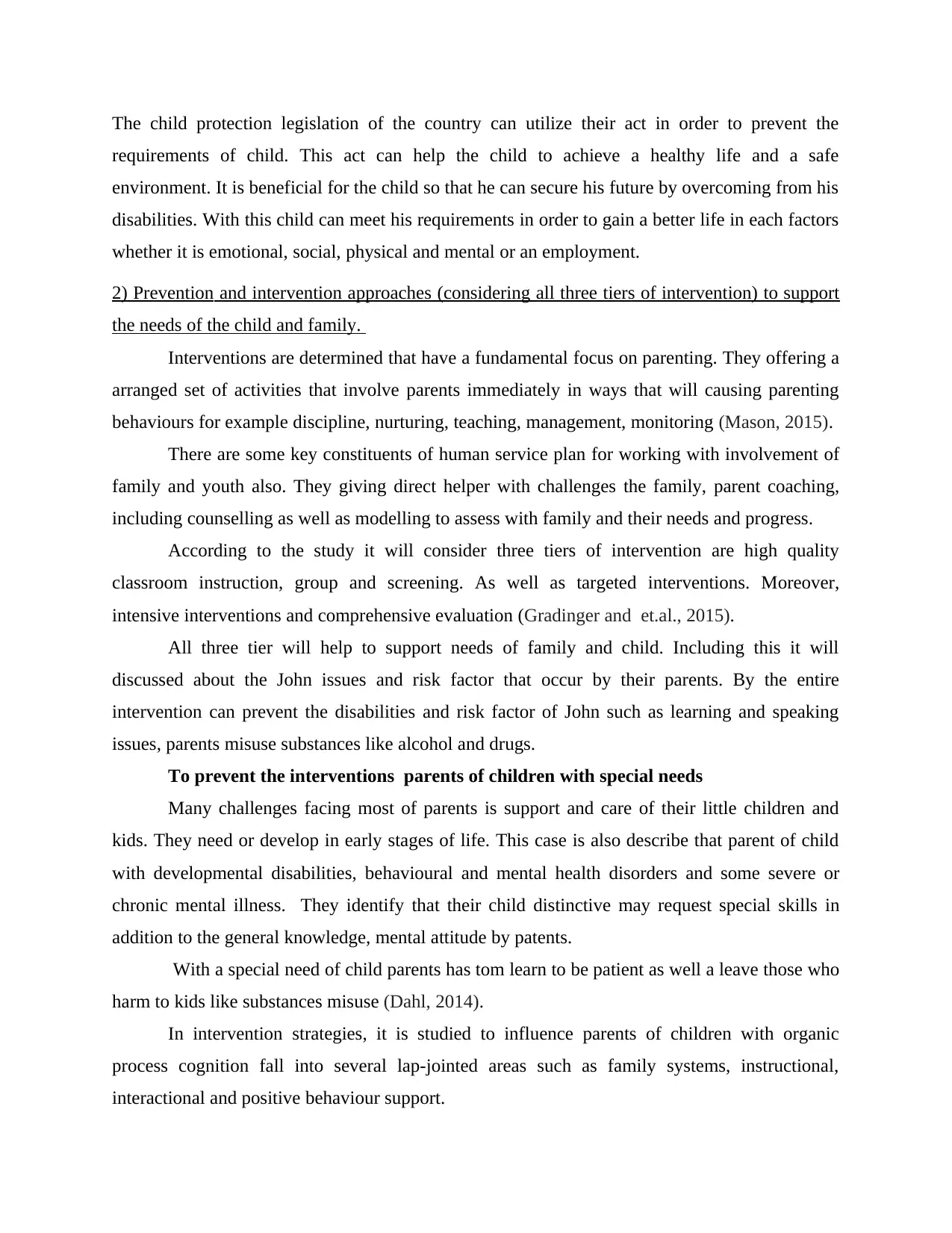
The child protection legislation of the country can utilize their act in order to prevent the
requirements of child. This act can help the child to achieve a healthy life and a safe
environment. It is beneficial for the child so that he can secure his future by overcoming from his
disabilities. With this child can meet his requirements in order to gain a better life in each factors
whether it is emotional, social, physical and mental or an employment.
2) Prevention and intervention approaches (considering all three tiers of intervention) to support
the needs of the child and family.
Interventions are determined that have a fundamental focus on parenting. They offering a
arranged set of activities that involve parents immediately in ways that will causing parenting
behaviours for example discipline, nurturing, teaching, management, monitoring (Mason, 2015).
There are some key constituents of human service plan for working with involvement of
family and youth also. They giving direct helper with challenges the family, parent coaching,
including counselling as well as modelling to assess with family and their needs and progress.
According to the study it will consider three tiers of intervention are high quality
classroom instruction, group and screening. As well as targeted interventions. Moreover,
intensive interventions and comprehensive evaluation (Gradinger and et.al., 2015).
All three tier will help to support needs of family and child. Including this it will
discussed about the John issues and risk factor that occur by their parents. By the entire
intervention can prevent the disabilities and risk factor of John such as learning and speaking
issues, parents misuse substances like alcohol and drugs.
To prevent the interventions parents of children with special needs
Many challenges facing most of parents is support and care of their little children and
kids. They need or develop in early stages of life. This case is also describe that parent of child
with developmental disabilities, behavioural and mental health disorders and some severe or
chronic mental illness. They identify that their child distinctive may request special skills in
addition to the general knowledge, mental attitude by patents.
With a special need of child parents has tom learn to be patient as well a leave those who
harm to kids like substances misuse (Dahl, 2014).
In intervention strategies, it is studied to influence parents of children with organic
process cognition fall into several lap-jointed areas such as family systems, instructional,
interactional and positive behaviour support.
requirements of child. This act can help the child to achieve a healthy life and a safe
environment. It is beneficial for the child so that he can secure his future by overcoming from his
disabilities. With this child can meet his requirements in order to gain a better life in each factors
whether it is emotional, social, physical and mental or an employment.
2) Prevention and intervention approaches (considering all three tiers of intervention) to support
the needs of the child and family.
Interventions are determined that have a fundamental focus on parenting. They offering a
arranged set of activities that involve parents immediately in ways that will causing parenting
behaviours for example discipline, nurturing, teaching, management, monitoring (Mason, 2015).
There are some key constituents of human service plan for working with involvement of
family and youth also. They giving direct helper with challenges the family, parent coaching,
including counselling as well as modelling to assess with family and their needs and progress.
According to the study it will consider three tiers of intervention are high quality
classroom instruction, group and screening. As well as targeted interventions. Moreover,
intensive interventions and comprehensive evaluation (Gradinger and et.al., 2015).
All three tier will help to support needs of family and child. Including this it will
discussed about the John issues and risk factor that occur by their parents. By the entire
intervention can prevent the disabilities and risk factor of John such as learning and speaking
issues, parents misuse substances like alcohol and drugs.
To prevent the interventions parents of children with special needs
Many challenges facing most of parents is support and care of their little children and
kids. They need or develop in early stages of life. This case is also describe that parent of child
with developmental disabilities, behavioural and mental health disorders and some severe or
chronic mental illness. They identify that their child distinctive may request special skills in
addition to the general knowledge, mental attitude by patents.
With a special need of child parents has tom learn to be patient as well a leave those who
harm to kids like substances misuse (Dahl, 2014).
In intervention strategies, it is studied to influence parents of children with organic
process cognition fall into several lap-jointed areas such as family systems, instructional,
interactional and positive behaviour support.
⊘ This is a preview!⊘
Do you want full access?
Subscribe today to unlock all pages.

Trusted by 1+ million students worldwide

To support the needs of child and family by intervention strategies for prevent the
physiological abuse to children are-
Family systems programmes following a systems approach in that they most usually
focus on parents inner uncertain for example stress, coping, depression bases on postulate that
alters in those changeable will impact the quality of parenting. The intervention in units had a
important effects on reducing psychological distress in parents and children with their
disabilities. These impacts can overcome to John family problems issues by these interventions
and preventions (Snape and et. al., 2014).
Positive Behaviour Support, with disabilities for parents of children and their behaviour
often poses challenges, results in negative parents child interaction. As well as develop great
stress for the parents (Brett, 2014).
There are many essential gaps in the area on interventions for parents of children with
developmental disabilities for example execution of intercession in natural environments and
help for child and family transitions. Though a primary feature of early intervention program of
John issues.
John parents consume substance misuse and after that his mother has to be hospitalized
by chronic mental illness. By this child is suffering many disabilities and because of parents their
home is unhygienic and malnourished etc. To overcome all problems, behavioural and mental
health challenges embrace a scope of nature and conditions. They should take help by health and
social care .
CONCLUSION
From the give case, it has been concluded that the child is facing many difficulties in his life. He
faces many problems which includes the stuttering, difficulties in learning. These problems can
impact on his future. Many problems can occur in his future like difficulties in making career,
problems in engaging with other people and with his age of people. To prevent this problems
there are many laws which work for child welfare. Their aim is to provide the better environment
in which child can grow up and can but their mental state. Their laws includes the foster homes
which provide the child a better environment from their previous home. They work on the
principles such as to take inception monthly so that they can aware of, if any type of violence are
present or not in the house. From this, the mental state of child can be prevent.
physiological abuse to children are-
Family systems programmes following a systems approach in that they most usually
focus on parents inner uncertain for example stress, coping, depression bases on postulate that
alters in those changeable will impact the quality of parenting. The intervention in units had a
important effects on reducing psychological distress in parents and children with their
disabilities. These impacts can overcome to John family problems issues by these interventions
and preventions (Snape and et. al., 2014).
Positive Behaviour Support, with disabilities for parents of children and their behaviour
often poses challenges, results in negative parents child interaction. As well as develop great
stress for the parents (Brett, 2014).
There are many essential gaps in the area on interventions for parents of children with
developmental disabilities for example execution of intercession in natural environments and
help for child and family transitions. Though a primary feature of early intervention program of
John issues.
John parents consume substance misuse and after that his mother has to be hospitalized
by chronic mental illness. By this child is suffering many disabilities and because of parents their
home is unhygienic and malnourished etc. To overcome all problems, behavioural and mental
health challenges embrace a scope of nature and conditions. They should take help by health and
social care .
CONCLUSION
From the give case, it has been concluded that the child is facing many difficulties in his life. He
faces many problems which includes the stuttering, difficulties in learning. These problems can
impact on his future. Many problems can occur in his future like difficulties in making career,
problems in engaging with other people and with his age of people. To prevent this problems
there are many laws which work for child welfare. Their aim is to provide the better environment
in which child can grow up and can but their mental state. Their laws includes the foster homes
which provide the child a better environment from their previous home. They work on the
principles such as to take inception monthly so that they can aware of, if any type of violence are
present or not in the house. From this, the mental state of child can be prevent.
Paraphrase This Document
Need a fresh take? Get an instant paraphrase of this document with our AI Paraphraser
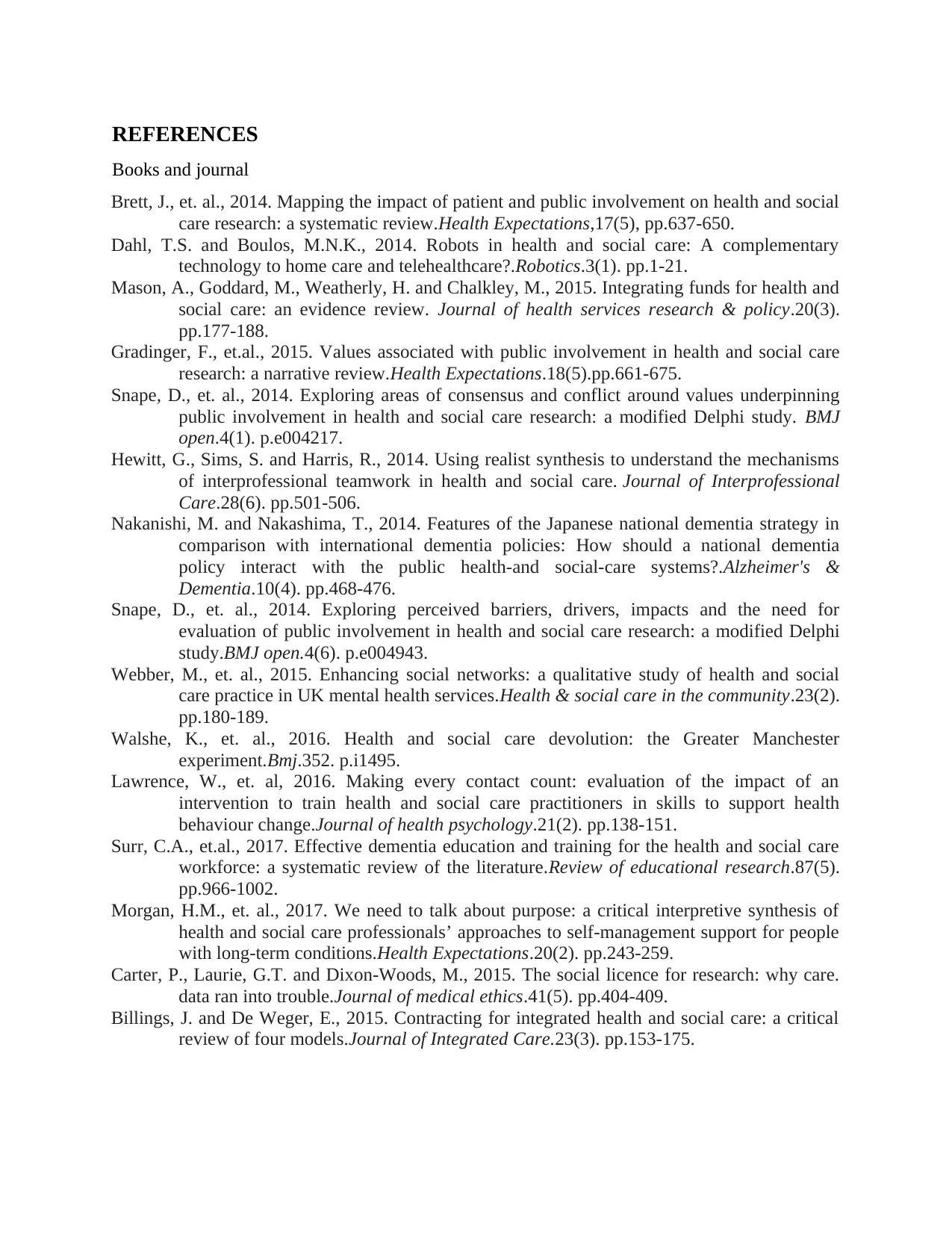
REFERENCES
Books and journal
Brett, J., et. al., 2014. Mapping the impact of patient and public involvement on health and social
care research: a systematic review.Health Expectations,17(5), pp.637-650.
Dahl, T.S. and Boulos, M.N.K., 2014. Robots in health and social care: A complementary
technology to home care and telehealthcare?.Robotics.3(1). pp.1-21.
Mason, A., Goddard, M., Weatherly, H. and Chalkley, M., 2015. Integrating funds for health and
social care: an evidence review. Journal of health services research & policy.20(3).
pp.177-188.
Gradinger, F., et.al., 2015. Values associated with public involvement in health and social care
research: a narrative review.Health Expectations.18(5).pp.661-675.
Snape, D., et. al., 2014. Exploring areas of consensus and conflict around values underpinning
public involvement in health and social care research: a modified Delphi study. BMJ
open.4(1). p.e004217.
Hewitt, G., Sims, S. and Harris, R., 2014. Using realist synthesis to understand the mechanisms
of interprofessional teamwork in health and social care. Journal of Interprofessional
Care.28(6). pp.501-506.
Nakanishi, M. and Nakashima, T., 2014. Features of the Japanese national dementia strategy in
comparison with international dementia policies: How should a national dementia
policy interact with the public health-and social-care systems?.Alzheimer's &
Dementia.10(4). pp.468-476.
Snape, D., et. al., 2014. Exploring perceived barriers, drivers, impacts and the need for
evaluation of public involvement in health and social care research: a modified Delphi
study.BMJ open.4(6). p.e004943.
Webber, M., et. al., 2015. Enhancing social networks: a qualitative study of health and social
care practice in UK mental health services.Health & social care in the community.23(2).
pp.180-189.
Walshe, K., et. al., 2016. Health and social care devolution: the Greater Manchester
experiment.Bmj.352. p.i1495.
Lawrence, W., et. al, 2016. Making every contact count: evaluation of the impact of an
intervention to train health and social care practitioners in skills to support health
behaviour change.Journal of health psychology.21(2). pp.138-151.
Surr, C.A., et.al., 2017. Effective dementia education and training for the health and social care
workforce: a systematic review of the literature.Review of educational research.87(5).
pp.966-1002.
Morgan, H.M., et. al., 2017. We need to talk about purpose: a critical interpretive synthesis of
health and social care professionals’ approaches to self‐management support for people
with long‐term conditions.Health Expectations.20(2). pp.243-259.
Carter, P., Laurie, G.T. and Dixon-Woods, M., 2015. The social licence for research: why care.
data ran into trouble.Journal of medical ethics.41(5). pp.404-409.
Billings, J. and De Weger, E., 2015. Contracting for integrated health and social care: a critical
review of four models.Journal of Integrated Care.23(3). pp.153-175.
Books and journal
Brett, J., et. al., 2014. Mapping the impact of patient and public involvement on health and social
care research: a systematic review.Health Expectations,17(5), pp.637-650.
Dahl, T.S. and Boulos, M.N.K., 2014. Robots in health and social care: A complementary
technology to home care and telehealthcare?.Robotics.3(1). pp.1-21.
Mason, A., Goddard, M., Weatherly, H. and Chalkley, M., 2015. Integrating funds for health and
social care: an evidence review. Journal of health services research & policy.20(3).
pp.177-188.
Gradinger, F., et.al., 2015. Values associated with public involvement in health and social care
research: a narrative review.Health Expectations.18(5).pp.661-675.
Snape, D., et. al., 2014. Exploring areas of consensus and conflict around values underpinning
public involvement in health and social care research: a modified Delphi study. BMJ
open.4(1). p.e004217.
Hewitt, G., Sims, S. and Harris, R., 2014. Using realist synthesis to understand the mechanisms
of interprofessional teamwork in health and social care. Journal of Interprofessional
Care.28(6). pp.501-506.
Nakanishi, M. and Nakashima, T., 2014. Features of the Japanese national dementia strategy in
comparison with international dementia policies: How should a national dementia
policy interact with the public health-and social-care systems?.Alzheimer's &
Dementia.10(4). pp.468-476.
Snape, D., et. al., 2014. Exploring perceived barriers, drivers, impacts and the need for
evaluation of public involvement in health and social care research: a modified Delphi
study.BMJ open.4(6). p.e004943.
Webber, M., et. al., 2015. Enhancing social networks: a qualitative study of health and social
care practice in UK mental health services.Health & social care in the community.23(2).
pp.180-189.
Walshe, K., et. al., 2016. Health and social care devolution: the Greater Manchester
experiment.Bmj.352. p.i1495.
Lawrence, W., et. al, 2016. Making every contact count: evaluation of the impact of an
intervention to train health and social care practitioners in skills to support health
behaviour change.Journal of health psychology.21(2). pp.138-151.
Surr, C.A., et.al., 2017. Effective dementia education and training for the health and social care
workforce: a systematic review of the literature.Review of educational research.87(5).
pp.966-1002.
Morgan, H.M., et. al., 2017. We need to talk about purpose: a critical interpretive synthesis of
health and social care professionals’ approaches to self‐management support for people
with long‐term conditions.Health Expectations.20(2). pp.243-259.
Carter, P., Laurie, G.T. and Dixon-Woods, M., 2015. The social licence for research: why care.
data ran into trouble.Journal of medical ethics.41(5). pp.404-409.
Billings, J. and De Weger, E., 2015. Contracting for integrated health and social care: a critical
review of four models.Journal of Integrated Care.23(3). pp.153-175.

⊘ This is a preview!⊘
Do you want full access?
Subscribe today to unlock all pages.

Trusted by 1+ million students worldwide
1 out of 12
Related Documents
Your All-in-One AI-Powered Toolkit for Academic Success.
+13062052269
info@desklib.com
Available 24*7 on WhatsApp / Email
![[object Object]](/_next/static/media/star-bottom.7253800d.svg)
Unlock your academic potential
Copyright © 2020–2025 A2Z Services. All Rights Reserved. Developed and managed by ZUCOL.





